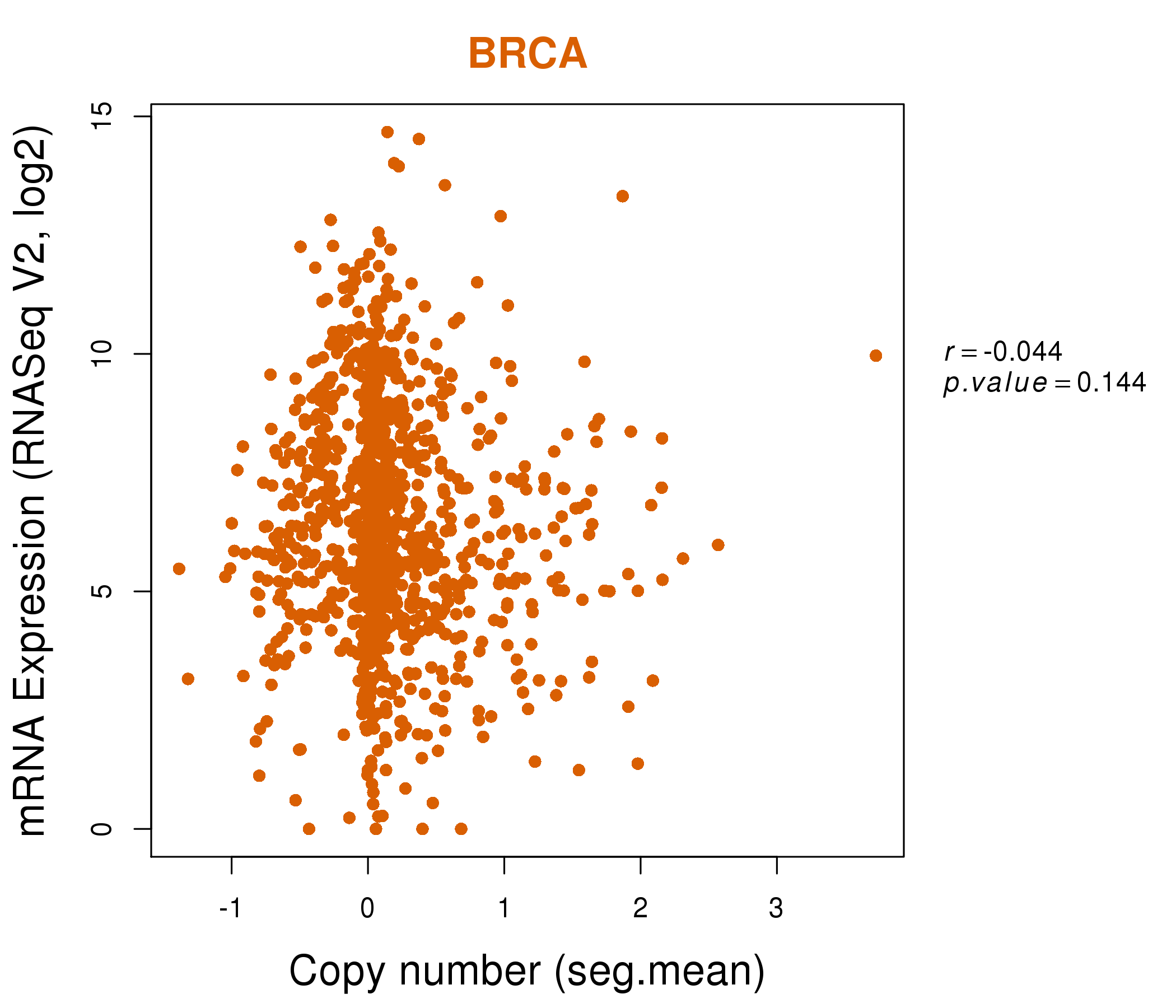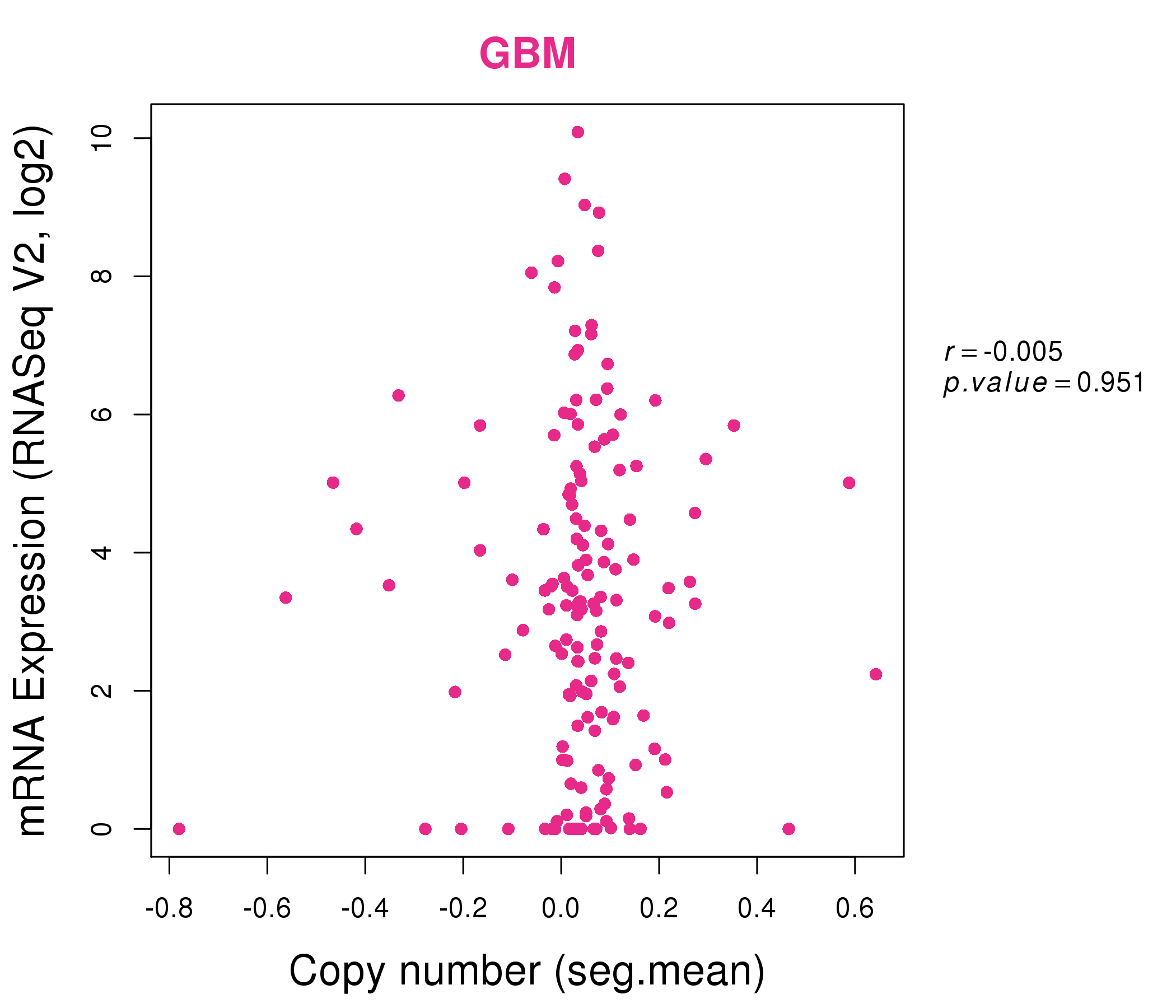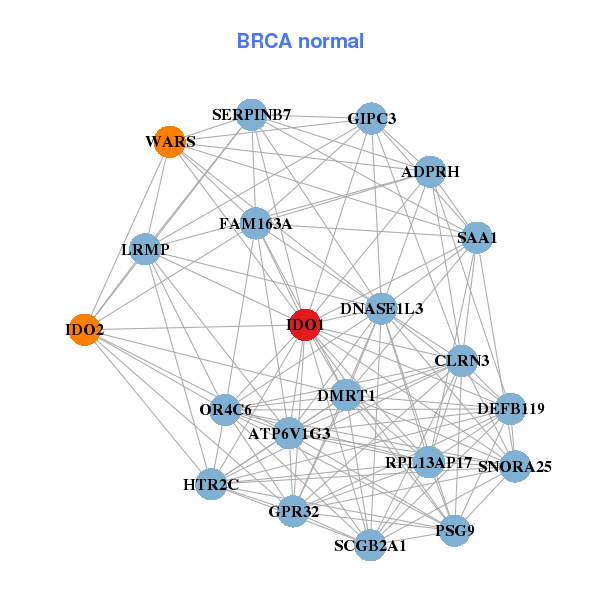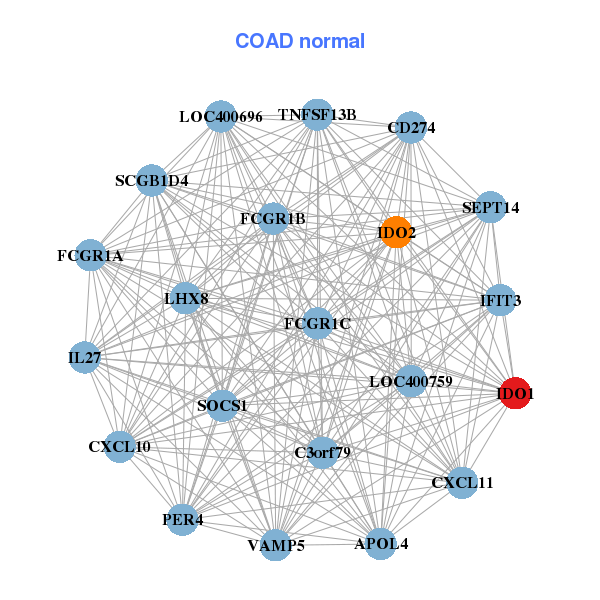|
||||||||||||||||||||||||||||||||||||||||||||||||||||||||||||||||||||||||||||||||||||||||||||||||||||||||||||||||||||||||||||||||||||||||||||||||||||||||||||||||||||||||||||||||||||||||||||||||||||||||||||||||||||||||||||||||||||||||||||||||||||||||||||||||||||||||||||||||||||||||||||||||||||||||||||||||||||||||||
| |
| Phenotypic Information (metabolism pathway, cancer, disease, phenome) |
| |
| |
| Gene-Gene Network Information: Co-Expression Network, Interacting Genes & KEGG |
| |
|
| Gene Summary for IDO1 |
| Basic gene info. | Gene symbol | IDO1 |
| Gene name | indoleamine 2,3-dioxygenase 1 | |
| Synonyms | IDO|IDO-1|INDO | |
| Cytomap | UCSC genome browser: 8p12-p11 | |
| Genomic location | chr8 :39771327-39786309 | |
| Type of gene | protein-coding | |
| RefGenes | NM_002164.5, | |
| Ensembl id | ENSG00000131203 | |
| Description | indolamine 2,3 dioxygenaseindole 2,3-dioxygenaseindoleamine-pyrrole 2,3-dioxygenase | |
| Modification date | 20141222 | |
| dbXrefs | MIM : 147435 | |
| HGNC : HGNC | ||
| HPRD : 00935 | ||
| Protein | UniProt: go to UniProt's Cross Reference DB Table | |
| Expression | CleanEX: HS_IDO1 | |
| BioGPS: 3620 | ||
| Gene Expression Atlas: ENSG00000131203 | ||
| The Human Protein Atlas: ENSG00000131203 | ||
| Pathway | NCI Pathway Interaction Database: IDO1 | |
| KEGG: IDO1 | ||
| REACTOME: IDO1 | ||
| ConsensusPathDB | ||
| Pathway Commons: IDO1 | ||
| Metabolism | MetaCyc: IDO1 | |
| HUMANCyc: IDO1 | ||
| Regulation | Ensembl's Regulation: ENSG00000131203 | |
| miRBase: chr8 :39,771,327-39,786,309 | ||
| TargetScan: NM_002164 | ||
| cisRED: ENSG00000131203 | ||
| Context | iHOP: IDO1 | |
| cancer metabolism search in PubMed: IDO1 | ||
| UCL Cancer Institute: IDO1 | ||
| Assigned class in ccmGDB | A - This gene has a literature evidence and it belongs to cancer gene. | |
| References showing role of IDO1 in cancer cell metabolism | 1. Gostner JM, Becker K, Uberall F, Fuchs D (2015) The potential of targeting indoleamine 2,3-dioxygenase for cancer treatment. Expert Opin Ther Targets 19: 605-615. doi: 10.1517/14728222.2014.995092. go to article 2. Lee YK, Lee HB, Shin DM, Kang MJ, Yi EC, et al. (2014) Heme-binding-mediated negative regulation of the tryptophan metabolic enzyme indoleamine 2,3-dioxygenase 1 (IDO1) by IDO2. Exp Mol Med 46: e121. doi: 10.1038/emm.2014.69. pmid: 4261913. go to article 3. Tang X, Lin CC, Spasojevic I, Iversen ES, Chi JT, et al. (2014) A joint analysis of metabolomics and genetics of breast cancer. Breast Cancer Res 16: 415. doi: 10.1186/s13058-014-0415-9. pmid: 4187326. go to article | |
| Top |
| Phenotypic Information for IDO1(metabolism pathway, cancer, disease, phenome) |
| Cancer | CGAP: IDO1 |
| Familial Cancer Database: IDO1 | |
| * This gene is included in those cancer gene databases. |
|
|
|
|
|
|
| ||||||||||||||||||||||||||||||||||||||||||||||||||||||||||||||||||||||||||||||||||||||||||||||||||||||||||||||||||||||||||||||||||||||||||||||||||||||||||||||||||||||||||||||||||||||||||||||||||||||||||||||||||||||||||||||||||||||||||||||||||||||||||||||||||||||||||||||||||||||||||||||||||||||||||||||||||||
Oncogene 1 | Significant driver gene in | |||||||||||||||||||||||||||||||||||||||||||||||||||||||||||||||||||||||||||||||||||||||||||||||||||||||||||||||||||||||||||||||||||||||||||||||||||||||||||||||||||||||||||||||||||||||||||||||||||||||||||||||||||||||||||||||||||||||||||||||||||||||||||||||||||||||||||||||||||||||||||||||||||||||||||||||||||||||||
| cf) number; DB name 1 Oncogene; http://nar.oxfordjournals.org/content/35/suppl_1/D721.long, 2 Tumor Suppressor gene; https://bioinfo.uth.edu/TSGene/, 3 Cancer Gene Census; http://www.nature.com/nrc/journal/v4/n3/abs/nrc1299.html, 4 CancerGenes; http://nar.oxfordjournals.org/content/35/suppl_1/D721.long, 5 Network of Cancer Gene; http://ncg.kcl.ac.uk/index.php, 1Therapeutic Vulnerabilities in Cancer; http://cbio.mskcc.org/cancergenomics/statius/ |
| KEGG_TRYPTOPHAN_METABOLISM REACTOME_METABOLISM_OF_AMINO_ACIDS_AND_DERIVATIVES | |
| OMIM | |
| Orphanet | |
| Disease | KEGG Disease: IDO1 |
| MedGen: IDO1 (Human Medical Genetics with Condition) | |
| ClinVar: IDO1 | |
| Phenotype | MGI: IDO1 (International Mouse Phenotyping Consortium) |
| PhenomicDB: IDO1 | |
| Mutations for IDO1 |
| * Under tables are showing count per each tissue to give us broad intuition about tissue specific mutation patterns.You can go to the detailed page for each mutation database's web site. |
| - Statistics for Tissue and Mutation type | Top |
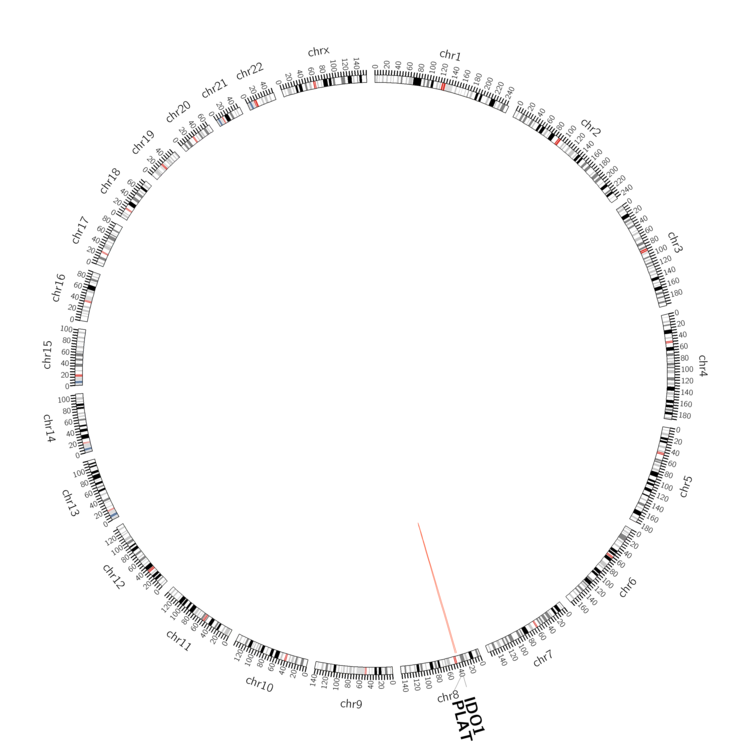 |
| - For Inter-chromosomal Variations |
| There's no inter-chromosomal structural variation. |
| - For Intra-chromosomal Variations |
| * Intra-chromosomal variantions includes 'intrachromosomal amplicon to amplicon', 'intrachromosomal amplicon to non-amplified dna', 'intrachromosomal deletion', 'intrachromosomal fold-back inversion', 'intrachromosomal inversion', 'intrachromosomal tandem duplication', 'Intrachromosomal unknown type', 'intrachromosomal with inverted orientation', 'intrachromosomal with non-inverted orientation'. |
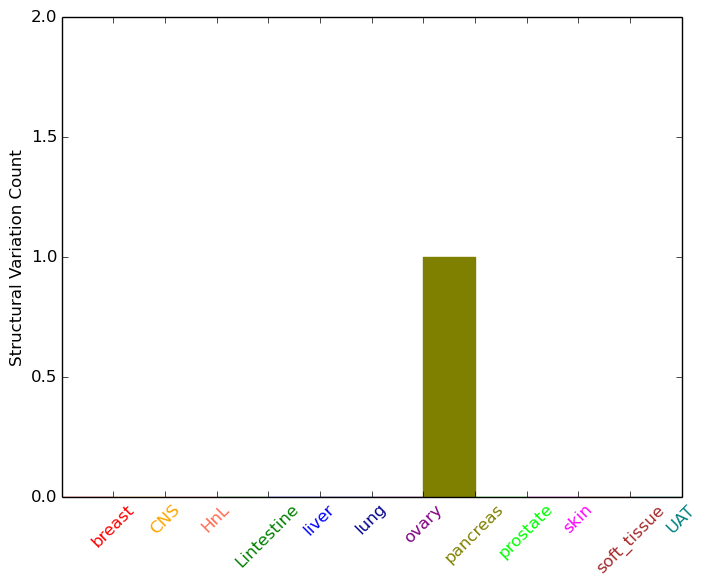 |
| Sample | Symbol_a | Chr_a | Start_a | End_a | Symbol_b | Chr_b | Start_b | End_b |
| pancreas | IDO1 | chr8 | 39774237 | 39774257 | PLAT | chr8 | 42034472 | 42034492 |
| cf) Tissue number; Tissue name (1;Breast, 2;Central_nervous_system, 3;Haematopoietic_and_lymphoid_tissue, 4;Large_intestine, 5;Liver, 6;Lung, 7;Ovary, 8;Pancreas, 9;Prostate, 10;Skin, 11;Soft_tissue, 12;Upper_aerodigestive_tract) |
| * From mRNA Sanger sequences, Chitars2.0 arranged chimeric transcripts. This table shows IDO1 related fusion information. |
| ID | Head Gene | Tail Gene | Accession | Gene_a | qStart_a | qEnd_a | Chromosome_a | tStart_a | tEnd_a | Gene_a | qStart_a | qEnd_a | Chromosome_a | tStart_a | tEnd_a |
| BF917390 | IDO1 | 12 | 263 | 8 | 39775666 | 39780127 | IPO4 | 256 | 381 | 14 | 24658579 | 24658704 | |
| BF871880 | EXOSC10 | 25 | 227 | 1 | 11132188 | 11134373 | IDO1 | 215 | 402 | 8 | 39785479 | 39785666 | |
| BE172266 | IDO1 | 103 | 126 | 8 | 39777650 | 39777673 | NUFIP2 | 120 | 228 | 17 | 27582971 | 27583079 | |
| Top |
| Mutation type/ Tissue ID | brca | cns | cerv | endome | haematopo | kidn | Lintest | liver | lung | ns | ovary | pancre | prost | skin | stoma | thyro | urina | |||
| Total # sample | 1 | |||||||||||||||||||
| GAIN (# sample) | 1 | |||||||||||||||||||
| LOSS (# sample) |
| cf) Tissue ID; Tissue type (1; Breast, 2; Central_nervous_system, 3; Cervix, 4; Endometrium, 5; Haematopoietic_and_lymphoid_tissue, 6; Kidney, 7; Large_intestine, 8; Liver, 9; Lung, 10; NS, 11; Ovary, 12; Pancreas, 13; Prostate, 14; Skin, 15; Stomach, 16; Thyroid, 17; Urinary_tract) |
| Top |
|
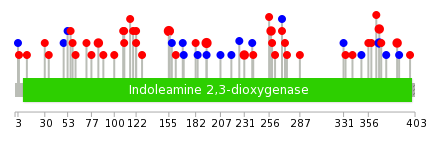 |
| Top |
| Stat. for Non-Synonymous SNVs (# total SNVs=37) | (# total SNVs=12) |
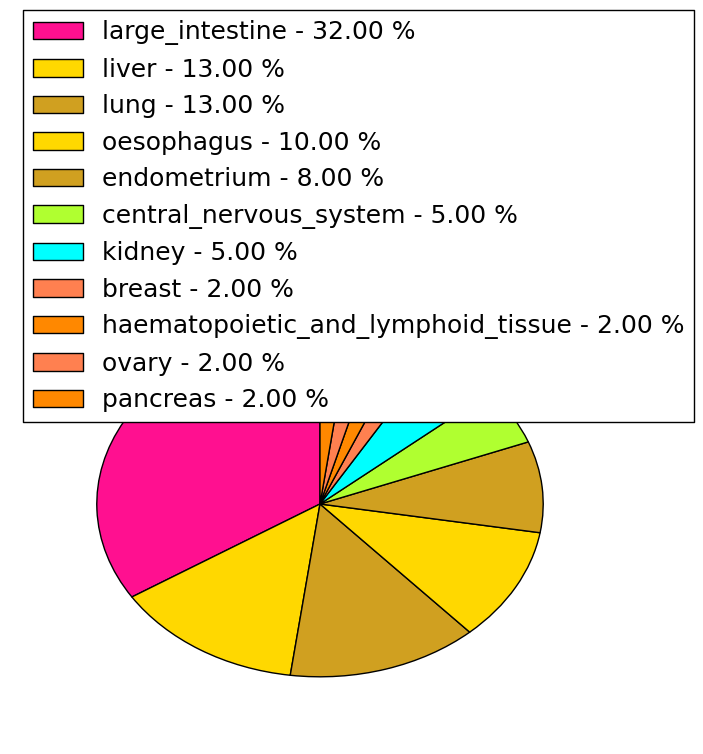 | 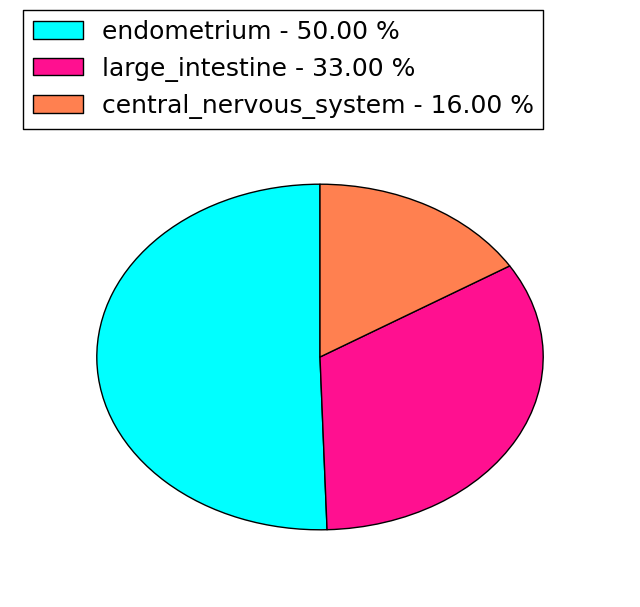 |
(# total SNVs=1) | (# total SNVs=0) |
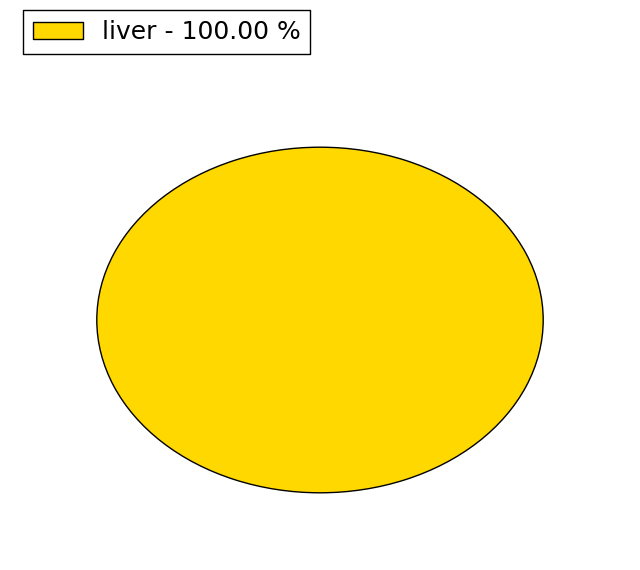 |
| Top |
| * When you move the cursor on each content, you can see more deailed mutation information on the Tooltip. Those are primary_site,primary_histology,mutation(aa),pubmedID. |
| GRCh37 position | Mutation(aa) | Unique sampleID count |
| chr8:39781028-39781028 | p.R193Q | 3 |
| chr8:39780096-39780096 | p.R155C | 3 |
| chr8:39785646-39785646 | p.M385T | 2 |
| chr8:39775673-39775673 | p.G84R | 2 |
| chr8:39782275-39782275 | p.R231C | 2 |
| chr8:39776358-39776358 | p.P110T | 2 |
| chr8:39785591-39785591 | p.T367A | 2 |
| chr8:39785593-39785593 | p.T367T | 2 |
| chr8:39782806-39782806 | p.E258K | 2 |
| chr8:39776391-39776393 | p.P122delP | 1 |
| Top |
|
 |
| Point Mutation/ Tissue ID | 1 | 2 | 3 | 4 | 5 | 6 | 7 | 8 | 9 | 10 | 11 | 12 | 13 | 14 | 15 | 16 | 17 | 18 | 19 | 20 |
| # sample | 12 | 3 | 3 | 1 | 2 | 2 | 1 | 17 | 1 | 1 | 8 | |||||||||
| # mutation | 12 | 3 | 3 | 1 | 2 | 2 | 1 | 18 | 1 | 1 | 8 | |||||||||
| nonsynonymous SNV | 8 | 2 | 3 | 1 | 2 | 2 | 1 | 11 | 1 | 1 | 2 | |||||||||
| synonymous SNV | 4 | 1 | 7 | 6 |
| cf) Tissue ID; Tissue type (1; BLCA[Bladder Urothelial Carcinoma], 2; BRCA[Breast invasive carcinoma], 3; CESC[Cervical squamous cell carcinoma and endocervical adenocarcinoma], 4; COAD[Colon adenocarcinoma], 5; GBM[Glioblastoma multiforme], 6; Glioma Low Grade, 7; HNSC[Head and Neck squamous cell carcinoma], 8; KICH[Kidney Chromophobe], 9; KIRC[Kidney renal clear cell carcinoma], 10; KIRP[Kidney renal papillary cell carcinoma], 11; LAML[Acute Myeloid Leukemia], 12; LUAD[Lung adenocarcinoma], 13; LUSC[Lung squamous cell carcinoma], 14; OV[Ovarian serous cystadenocarcinoma ], 15; PAAD[Pancreatic adenocarcinoma], 16; PRAD[Prostate adenocarcinoma], 17; SKCM[Skin Cutaneous Melanoma], 18:STAD[Stomach adenocarcinoma], 19:THCA[Thyroid carcinoma], 20:UCEC[Uterine Corpus Endometrial Carcinoma]) |
| Top |
| * We represented just top 10 SNVs. When you move the cursor on each content, you can see more deailed mutation information on the Tooltip. Those are primary_site, primary_histology, mutation(aa), pubmedID. |
| Genomic Position | Mutation(aa) | Unique sampleID count |
| chr8:39775722 | p.R100H | 3 |
| chr8:39780096 | p.T367A | 2 |
| chr8:39782806 | p.R155C | 2 |
| chr8:39785591 | p.E258K | 2 |
| chr8:39781104 | p.K61E | 1 |
| chr8:39775465 | p.R193R | 1 |
| chr8:39782854 | p.A331A | 1 |
| chr8:39785653 | p.D72N | 1 |
| chr8:39782262 | p.A204P | 1 |
| chr8:39775480 | p.D333G | 1 |
| * Copy number data were extracted from TCGA using R package TCGA-Assembler. The URLs of all public data files on TCGA DCC data server were gathered on Jan-05-2015. Function ProcessCNAData in TCGA-Assembler package was used to obtain gene-level copy number value which is calculated as the average copy number of the genomic region of a gene. |
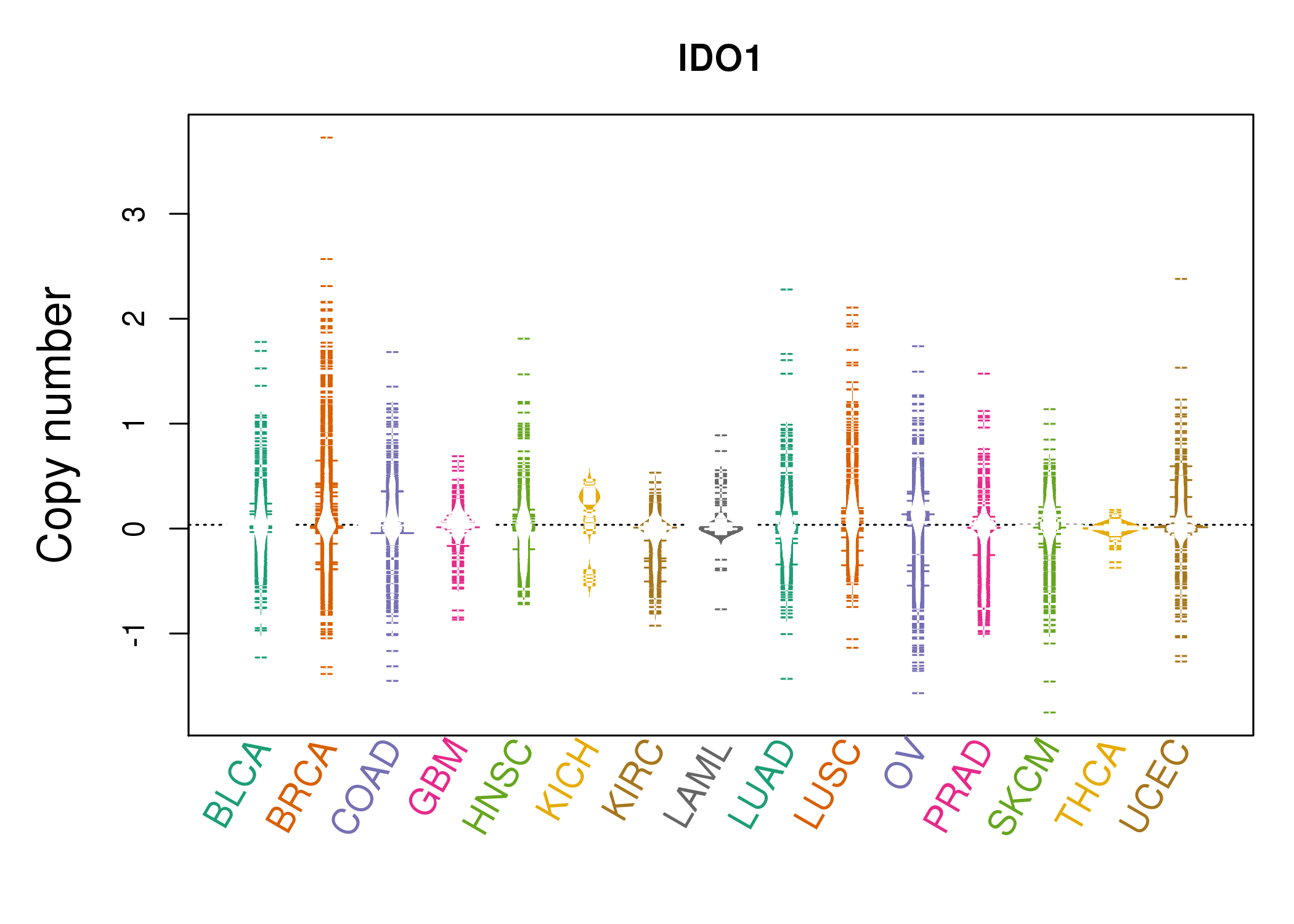 |
| cf) Tissue ID[Tissue type]: BLCA[Bladder Urothelial Carcinoma], BRCA[Breast invasive carcinoma], CESC[Cervical squamous cell carcinoma and endocervical adenocarcinoma], COAD[Colon adenocarcinoma], GBM[Glioblastoma multiforme], Glioma Low Grade, HNSC[Head and Neck squamous cell carcinoma], KICH[Kidney Chromophobe], KIRC[Kidney renal clear cell carcinoma], KIRP[Kidney renal papillary cell carcinoma], LAML[Acute Myeloid Leukemia], LUAD[Lung adenocarcinoma], LUSC[Lung squamous cell carcinoma], OV[Ovarian serous cystadenocarcinoma ], PAAD[Pancreatic adenocarcinoma], PRAD[Prostate adenocarcinoma], SKCM[Skin Cutaneous Melanoma], STAD[Stomach adenocarcinoma], THCA[Thyroid carcinoma], UCEC[Uterine Corpus Endometrial Carcinoma] |
| Top |
| Gene Expression for IDO1 |
| * CCLE gene expression data were extracted from CCLE_Expression_Entrez_2012-10-18.res: Gene-centric RMA-normalized mRNA expression data. |
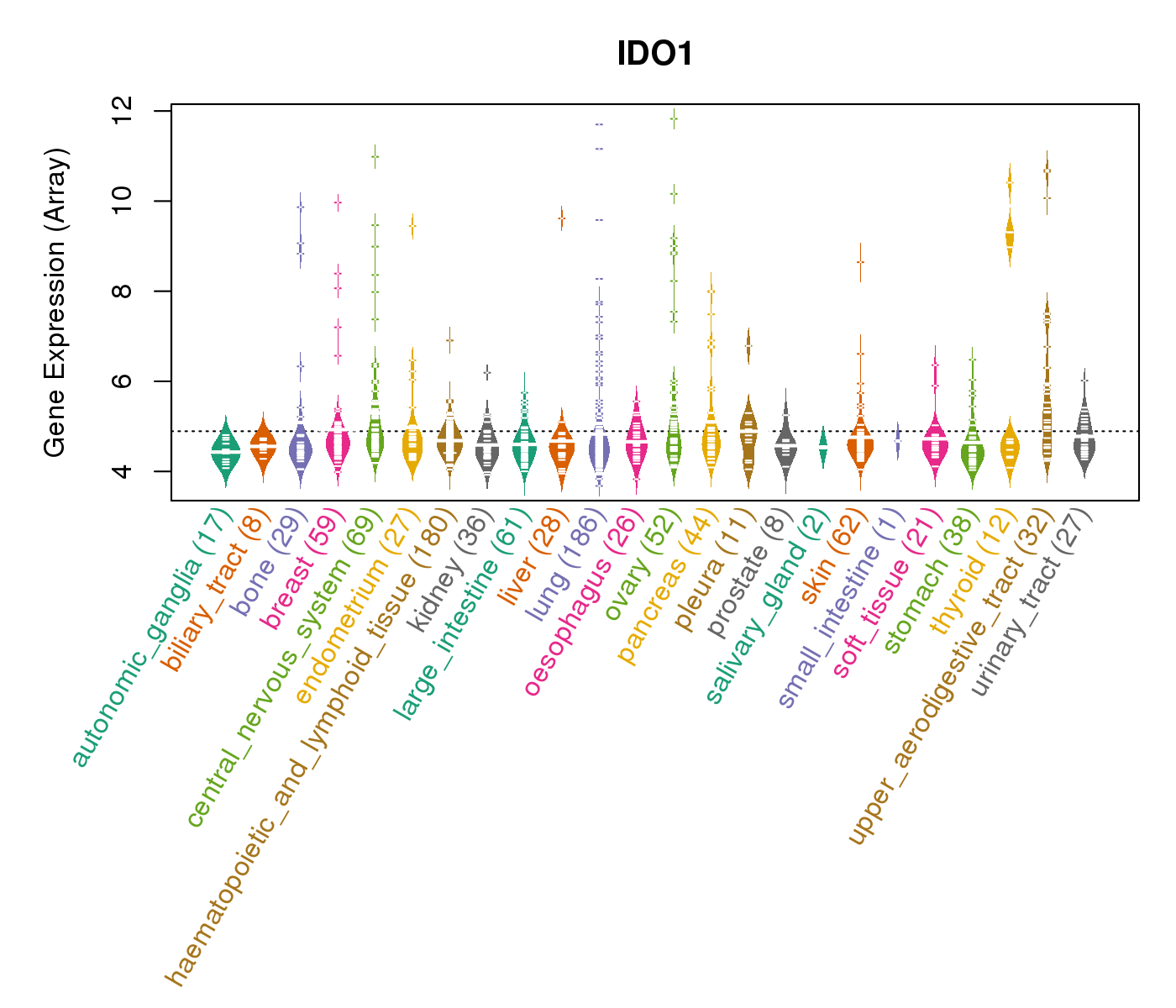 |
| * Normalized gene expression data of RNASeqV2 was extracted from TCGA using R package TCGA-Assembler. The URLs of all public data files on TCGA DCC data server were gathered at Jan-05-2015. Only eight cancer types have enough normal control samples for differential expression analysis. (t test, adjusted p<0.05 (using Benjamini-Hochberg FDR)) |
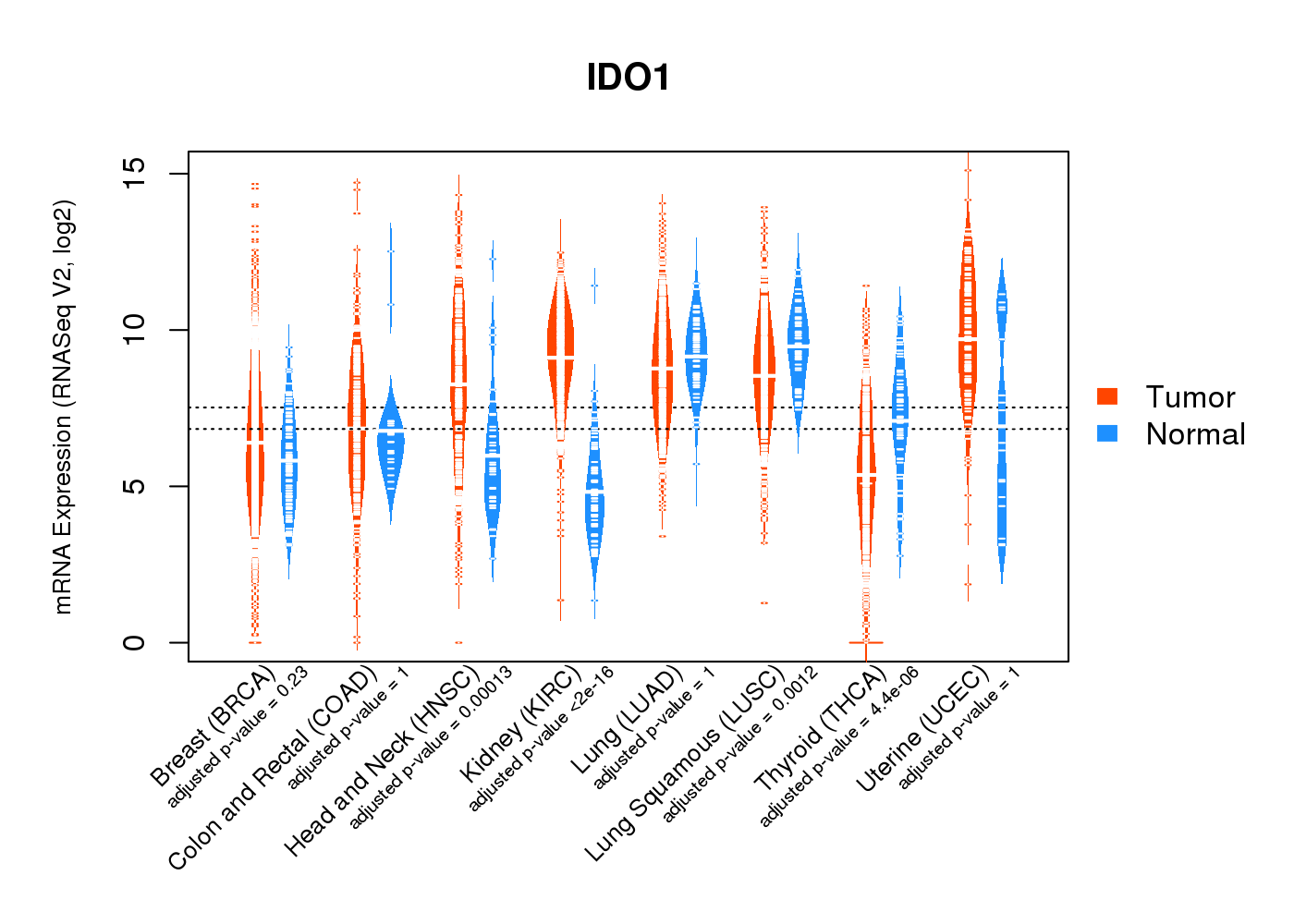 |
| Top |
| * This plots show the correlation between CNV and gene expression. |
: Open all plots for all cancer types
 |
|
 |
|
| Top |
| Gene-Gene Network Information |
| * Co-Expression network figures were drawn using R package igraph. Only the top 20 genes with the highest correlations were shown. Red circle: input gene, orange circle: cell metabolism gene, sky circle: other gene |
: Open all plots for all cancer types
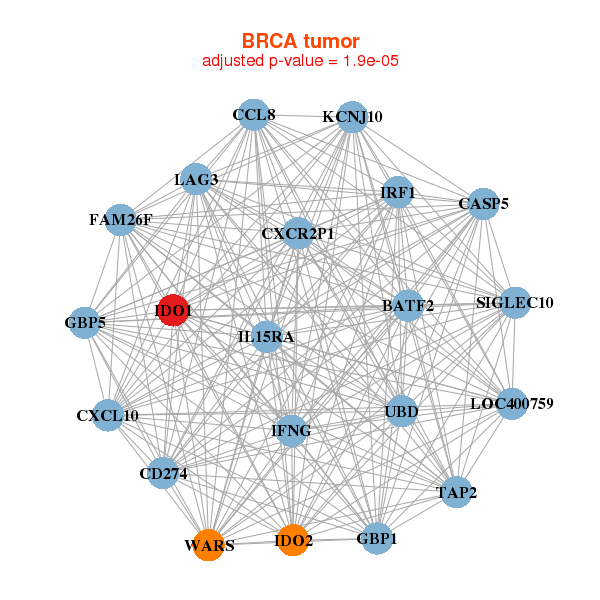 |
|
| BATF2,CASP5,CCL8,CD274,CXCL10,CXCR2P1,FAM26F, GBP1,GBP5,IDO1,IDO2,IFNG,IL15RA,IRF1, KCNJ10,LAG3,LOC400759,SIGLEC10,TAP2,UBD,WARS | ADPRH,ATP6V1G3,CLRN3,DEFB119,DMRT1,DNASE1L3,FAM163A, GIPC3,GPR32,HTR2C,IDO1,IDO2,LRMP,OR4C6, PSG9,RPL13AP17,SAA1,SCGB2A1,SERPINB7,SNORA25,WARS |
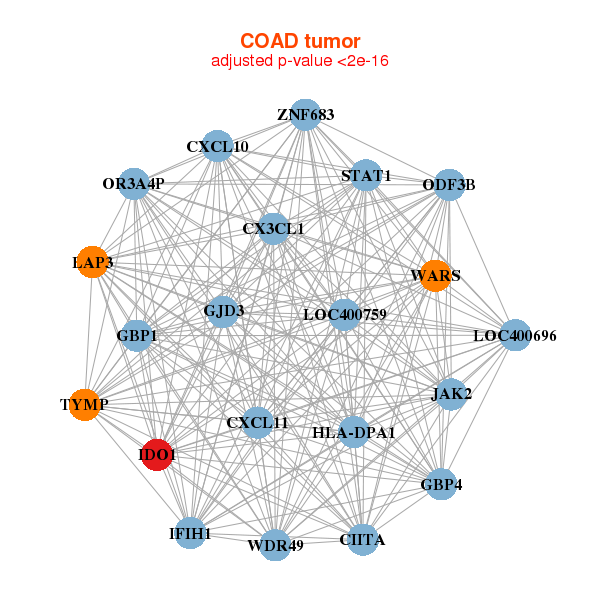 |
|
| CIITA,CX3CL1,CXCL10,CXCL11,GBP1,GBP4,GJD3, HLA-DPA1,IDO1,IFIH1,JAK2,LAP3,LOC400696,LOC400759, ODF3B,OR3A4P,STAT1,TYMP,WARS,WDR49,ZNF683 | APOL4,C3orf79,CD274,CXCL10,CXCL11,FCGR1A,FCGR1B, FCGR1C,IDO1,IDO2,IFIT3,IL27,LHX8,LOC400696, LOC400759,PER4,SCGB1D4,SEPT14,SOCS1,TNFSF13B,VAMP5 |
| * Co-Expression network figures were drawn using R package igraph. Only the top 20 genes with the highest correlations were shown. Red circle: input gene, orange circle: cell metabolism gene, sky circle: other gene |
: Open all plots for all cancer types
| Top |
: Open all interacting genes' information including KEGG pathway for all interacting genes from DAVID
| Top |
| Pharmacological Information for IDO1 |
| There's no related Drug. |
| Top |
| Cross referenced IDs for IDO1 |
| * We obtained these cross-references from Uniprot database. It covers 150 different DBs, 18 categories. http://www.uniprot.org/help/cross_references_section |
: Open all cross reference information
|
Copyright © 2016-Present - The Univsersity of Texas Health Science Center at Houston @ |






